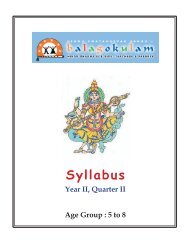Bauddhik Plan for Age Group 9-12 for the second ... - Balagokulam
Bauddhik Plan for Age Group 9-12 for the second ... - Balagokulam
Bauddhik Plan for Age Group 9-12 for the second ... - Balagokulam
Create successful ePaper yourself
Turn your PDF publications into a flip-book with our unique Google optimized e-Paper software.
AugustDharmaThe furniture, decor and <strong>the</strong> atmosphere of each room are made conduciveto <strong>the</strong> purpose it serves. So too <strong>for</strong> <strong>the</strong> purpose of meditation, worship andprayer, we should have a conducive atmosphere – hence <strong>the</strong> need <strong>for</strong> a prayerroom.Sacred thoughts and sound vibrations pervade <strong>the</strong> place and influence<strong>the</strong> minds of those who spend time <strong>the</strong>re. Spiritual thoughts and vibrationsaccumulated through regular meditation, worship and chanting done <strong>the</strong>repervade <strong>the</strong> prayer room. Even when we are tired or agitated, by just sittingin <strong>the</strong> prayer room <strong>for</strong> a while, we feel calm, rejuvenated and spirituallyuplifted.Why do we do Namaste?Hindus greet each o<strong>the</strong>r with namaste. The two palms are placed toge<strong>the</strong>rin front of <strong>the</strong> chest and <strong>the</strong> head bows whilst saying <strong>the</strong> word namaste. Thisgreeting is <strong>for</strong> all – people younger than us, of our own age, those older thanus, friends and even strangers.There are five <strong>for</strong>ms of <strong>for</strong>mal traditional greeting enjoined in <strong>the</strong>shaastras of which namaskaram is one. This is understood as prostration butit actually refers to paying homage as we do today when we greet each o<strong>the</strong>rwith a namaste.Namaste could be just a casual or <strong>for</strong>mal greeting, a cultural conventionor an act of worship. However <strong>the</strong>re is much more to it than meets <strong>the</strong> eye.In Sanskrit namah + te = namaste. It means – I bow to you – my greetings,salutations or prostration to you. Namaha can also be literally interpretedas “na ma” (not mine). It has a spiritual significance of negating or reducingone’s ego in <strong>the</strong> presence of ano<strong>the</strong>r.The real meeting between people is <strong>the</strong> meeting of <strong>the</strong>ir minds. When wegreet ano<strong>the</strong>r, we do so with namaste, which means, “may our minds meet,”indicated by <strong>the</strong> folded palms placed be<strong>for</strong>e <strong>the</strong> chest. The bowing down of <strong>the</strong>head is a gracious <strong>for</strong>m of extending friendship in love and humility.The spiritual meaning is even deeper. The life <strong>for</strong>ce, <strong>the</strong> divinity, <strong>the</strong>Self or <strong>the</strong> Lord in me is <strong>the</strong> same in all. Recognising this oneness with <strong>the</strong>meeting of <strong>the</strong> palms, we salute with head bowed <strong>the</strong> Divinity in <strong>the</strong> person wemeet. That is why sometimes, we close our eyes as we do namaste to a revered28Hindu Swayamsevak Sangh (HSS)
















